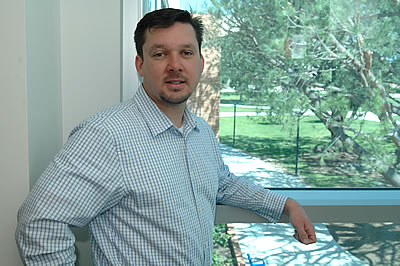May 4 , 2006
by Valerie Orleans
The bird flu has been in the news a lot as the virus spreads from China and Southeast Asia. Vincent C. Merrill, assistant professor of health science who teaches epidemiology, discusses some of the problems that could happen if the flu strain reaches Southern California.
| Q: |
We’ve had public health scares. Is this strain of flu that dangerous? |
| A: |
What makes those in health care particularly anxious is how virulent this flu is. So far, 205 people have contacted this strain of flu, and of those, 113 died. That’s more than a 55 percent fatality rate. flu viruses are usually more deadly to the young and elderly ... whose immune systems aren’t perhaps as strong. But in cases so far, the victims were young adults and for the most part, healthy. |
|
| Q: |
But aren’t those who have contracted the disease been farmers with close contact with poultry in less sanitary conditions than in the United States? |
| A: |
Yes, they were farmers or others who were handling fowl. And while this number is very small, it’s the virulent effects that have officials concerned. This is what public health is all about: watching diseases develop at very early stages and trying to figure out what to do if it becomes more serious.
Bird flus are quite common but the H5N1 strain is particularly deadly. So if there are precautions that can be taken before it becomes pandemic in humans, I believe we should. |
|
| Q: |
What would happen if it gets to poultry here? |
| A: |
Poultry farmers are very concerned. Those infected, as well as other area birds, would have to be euthanized to contain and prevent the spread of the virus. American farmers are taking appropriate precautions; keeping chickens indoors [away from migratory birds] and keeping a close eye on their flocks for any signs of disease. |
|
| Q: |
Would eating a contaminated bird cause someone to become sick? |
| A: |
I wouldn’t recommend it, but as long as it’s cooked properly, you’re not going to get bird flu. To date, there’s not been any evidence that cooked poultry products cause an infection. Some people think using antibacterial soap will help reduce the likelihood of contamination. Although advocate proper hygiene, this is not true — bird flu is a virus, not bacterial. |
|
| Q: |
What would have to happen to make human-to-human contagion possible? |
| A: |
The virus would have to mutate, at least once and possibly twice, to enable such transmission. virus normally attacks the lower respiratory tract, making it difficult to transmit and acquire. It would have to mutate, enabling it to take hold in the upper respiratory tract like most human-types of flu. also likely to become less deadly at that point. However, once human-to-human contagion begins, that’s when there’s real trouble. |
|
| Q: |
What would happen? |
| A: |
You would probably see typical flu symptoms — fever, cough and runny nose. You may see eye infections and pneumonia. Eventually, victims will experience acute respiratory distress. Fever, in particular, is a good warning sign. You also will see many normally healthy people stricken. |
|
| Q: |
What is your prognosis for the United States? |
| A: |
We’ll have to locate and isolate those with the virus to minimize its spread. Worldwide travel makes the spread of disease much easier. For instance, imagine that someone comes over from Asia, flies to New York, stays in a hotel, and then moves on to Washington, D.C., infecting hundreds who then go on to infect hundreds more. That’s when you’re looking at a pandemic developing.
Right now, I’d say the risk to the U.S. is relatively low ... but that could change. |
|
| Q: |
Why isn’t a vaccine being developed? |
| A: |
It’s hard to develop a vaccine without having the disease. We don’t know what mutation will happen yet. Some are encouraging the use of Tamiflu but it may have limited effects if this virus mutates differently. Also it will take time to develop and distribute an effective vaccine. That’s why isolating and containing the virus is so important. |
|
| Q: |
So is the risk real? |
| A: |
I think the actions are appropriate because we don’t know what will happen. Historically, there are usually three major flus each century. last three pandemics were caused by H1 viruses, not the H5 strains we have here. However, it’s good to be prepared. If large numbers of people are sick, it will be an incredible burden on businesses. People have a tendency to go in to work sick, especially those without sick leave. It will be up to businesses to enforce rules about health. If, in a worse case scenario, 40 percent of your workforce is out, there will be terrible repercussions. For instance, if 40 percent of farmers can’t farm and 40 percent of truckers can’t distribute food, how will we get our food?
If you want to prepare for a pandemic, I wouldn’t worry about facemasks and antibacterial soap. I would want a three-month supply of food and water. |
|
| Q: |
How can people keep up with the latest information? |
| A: |
The Department of Health and Human Services has an excellent Web site, www.pandemicflu.gov, as well as the Center for Disease Control and Prevention, www.cdc.gov. |
«
back to News Front
|
|
